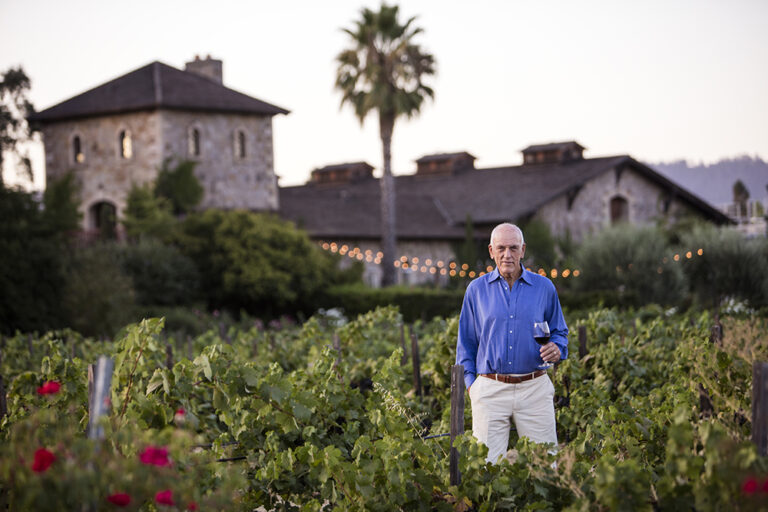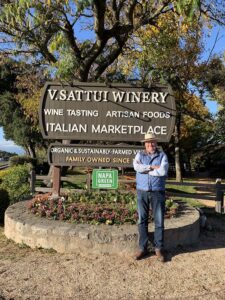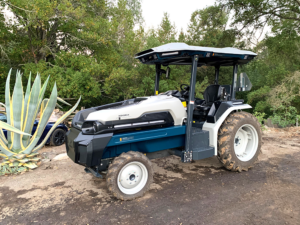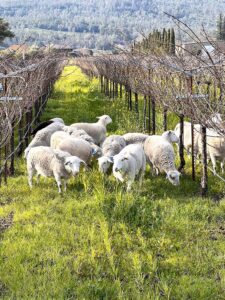
At first glance, V. Sattui Winery President Tom Davies and Owner and visionary Dario Sattui might have seemed like unlikely candidates for leading carbon reduction initiatives and farming organically at their two Napa estates. After 43 years in Napa, they were already quite successful in their two DTC wineries. So why change?
Their popular V. Sattui winery, with its cheese shop, gourmet takeout and picnicking, has been a hit with tourists for decades, and Dario’s inspired, authentic recreation, Castello di Amorosa, a medieval Tuscan castle, is a super popular tourist draw as well. Their estate farming operation, which provides 70% of their grapes, spans 350 acres growing 26 varieties in four counties. Everything is sold direct to consumer.
But lately, they’ve crossed a new business frontier, becoming evangelists for carbon footprint reduction and for organic farming. They’re now passionate about their greener path: starting a climate club, paying employees to carpool to work and converting all their estates to organic.
As Davies tells the story, the moves were inspired by two main events.
Inspiration #1: An Eye-Opening Climate Change Talk
One event was a talk on climate change and fossil fuels by Andrew M. Isaacs, a senior lecturer at UC Berkeley’s Haas School of Business on climate change and business strategy who lives in Napa. The recipient of the Haas School of Business Sustainability Teaching Award, Isaacs consults for hundreds of companies on how businesses can take effective action on climate change.
“He gave a talk at Napa Valley Grapegrowers. That day changed me,” said Davies.
The take home message? “‘At the end of the day, it’s all about carbon.’”
Davies turned a new leaf.
“I went out and I put solar in my house, I bought an electric car. I eliminated all plastic here at the winery… And on and on.
“We started a climate club here at the winery. And we now pay people up to $10 per day to carpool, a program which has been very successful.”

Inspiration #2: Local Documentary on Roundup
The second event was when a mutual friend introduced Davies and Sattui to documentary filmmaker Brian Lilla, who has been showing his documentary on Roundup and health concerns in local community screenings.
Said Davies, “We had not yet seen his film Children of the Vine. But we just thought he’d be an interesting person to talk to.”
“So, Brian says, ‘Look, I’d love for you both to see the documentary.’ So he gave us a link. Dario watched it at home. I watched it here in my office. And I think we absolutely were both taken aback…”
The film details medical and community concerns from Roundup’s critics about the controversial product’s alleged carcinogenicity which have since forced its manufacturer, Bayer, to pay out $11 billion in legal claims in the U.S.
Davies had already made the decision in late 2022 to stop using Roundup (a systemic herbicide that contains glyphosate) on the estates, so he was exploring other options including Lifeline herbicide (a contact herbicide that contains glufosinate ammonium) but wasn’t finding much data. “It’s not been studied to death as much as Roundup; there wasn’t a lot of information out there regarding Lifeline,” he said.
At the same time, Davies had already been farming organically for over a decade on a few vineyards adjacent to main roads (which enabled the company to put up signage saying those vineyards were certified organic), but those were only a small fraction of overall production.

“In the spring of 2023, I sat down [with] the vineyard team and said, ‘Okay, let’s pencil out maybe another ranch or so that we could begin the process of converting to organic.’ But then both Dario and I saw the film. I had sent Dario an email early in the morning that said, ‘Look, the only way around this dilemma is just to go organic.’
“He didn’t see my email, but called me the next day and said, ‘Let’s go organic 100%.’ So, we both came at it at the same time, but somewhat independently.
“We were almost there, but that film just kind of coalesced in my mind what we needed to be to be better stewards of our land.
“And within a period of less than a week, we decided to go 100% organic on all our ranches. So, it was pretty much a very quickly made decision, but one that we’ve fully embraced and continue to embrace today.”
The Learning Curve
Putting the plan into action began in spring 2023.
“We certainly have had our challenges this year because of that, and it’s been a quick learning curve,” Davies said, with terrain playing a major role as well as 2023’s abundant rain.

“The whole idea about farming organically is about soil health, right? That is really the name of the game,” he said.
“It’s one thing to farm organically on flatland, especially with weed control, but once you get up in the hills and rocky soils, it’s another ballgame… but we made that commitment. And that’s what we’re doing.
“Fungicide has been a big deal this past year, which was a high-pressure year for powdery mildew.”
The team has made new discoveries as well, he said, discovering hotspots that conventional chemical farming had masked, shifting to a new schedule of weekly spraying instead of spraying every other week with chemicals which led to logistical adjustments.
“We had to react quickly; that’s just the reality of farming, where you have so many tractors and so many crew members, and you need to get around in a very timely fashion. That’s just what it takes to farm.”
The Toolkit
The group implemented new techniques and new equipment to integrate organic practices and eliminate chemicals.
“For the first time this year, we brought sheep into our vineyards for grazing, and that was a great experience. We hope to expand that program,” he said.
Davies purchased some new equipment, namely two Monarch tractors and a Twister. The Twister can work well for weeding on hillsides, he said.
“We were able to take advantage of some of the rebates on these electric tractors, and we said, ‘Okay, let’s get a couple and see how they work.’ For doing sprays and stuff, they’re fantastic, even if they didn’t have quite the strengths of a traditional tractor.”
One unforeseen challenge of electric tractors: Wi-Fi connectivity. “With those tractors, we needed to get Wi-Fi connections to ranches that are in the middle of nowhere. We finally just got our Wi-Fi connection because we didn’t even have phone lines at some of those locations.
“We had some success with the Twister. But it meant that we had to come back eventually with shovels, so certainly there was an increase of labor there.”
The Results
It’s too early for Davies to assess the impacts financially overall due to the cool weather, the rain, and the newness of the practices coupled with above-average yields. “It was the coolest vintage we’ve had in 20+ years,” he said, yet his yields on some varieties were up 20% over averages over the last five years.
It also remains to be seen whether it’s profitable to farm organically on all varieties or just some varieties, he said. “It will take us many years to measure, but what I’m proud of is that we took the bold step as a winery.”
While the wineries do not currently label the wines with organic certification, since they hand-sell everything, organic is a big talking point with consumers, he said. “We really do get to talk to virtually everyone that buys our wines… we like to shout from the rooftops that we are farming organically because we’re very proud of that.
“This is just one of the ways we demonstrate our dedication and stewardship of our environment. There’s many other things we do as well, but this is really important for the sustainability of our winegrowing economy and certainly to our community and to our laborers in the fields…”
Before the plans were put into place, employee reaction was uncertain, Davies said. The vineyard crew consists of 25 year-round employees.
“Some of the team members who were watching out for the financial health of the company were not sure,” he said. “I think there was some apprehension.
“But when we made the decision, everyone was 100% on board, and our vineyard manager, David Bejar, said to me, ‘Thank you, Tom. Our crew thanks you. It just shows you really care, not only about the environment, but you care for our team members and their health.’
“And that, you know, that made me feel really good. It’s created more work for them… I think it was a real challenge for them, but even given that challenge, they stepped up and I think they feel really good about it.
“It’s certainly my hope down the road that with these healthier soils, healthier vines, we will see increased longevity. What if we were able to get another 5 to 10 years out of a Cabernet Sauvignon vineyard? That’s real money right there.”
His dream goes further.
“What if the Napa Valley was the very first wine region to become 100% fully organic? That would be such an amazing day. I think it’s certainly a very doable dream.
“What a great thing we could do for our community because we are an ag-based community, we’re a tourism-based community. Both those things have to go hand-in-hand for us too. I want to be able to sustain what we have. And if we can’t continue to get buy-in from our community, for our community to embrace us, this whole thing can kind of collapse. And I just think this is how we can become a better part of our community. And continue with this for many more generations to come.
“You don’t want to be late to the game. We can be at the forefront of that. It just puts us in a much better position for us to have our continued success here.”











